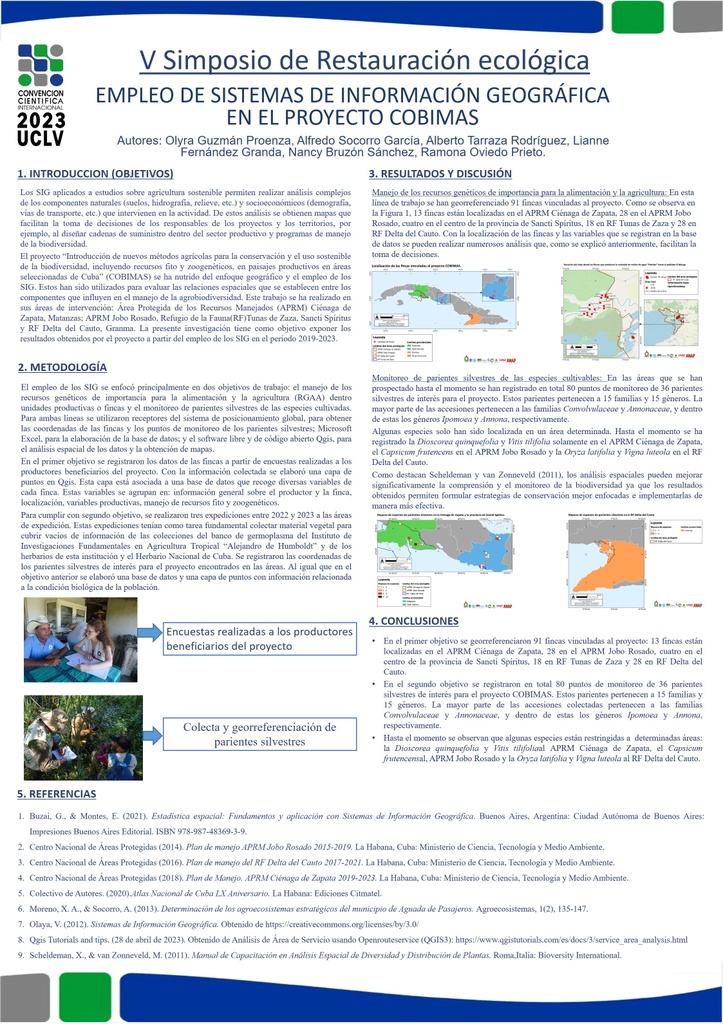Executive Secretary

9th International Scientific Conference on Agricultural Development and Sustainability
10th Symposium of Agricultural Engineering

Abstract
The project "Introduction of new agricultural methods for the conservation and sustainable use of biodiversity, including plant and animal genetic resources, in productive landscapes in selected areas of Cuba" (COBIMAS), has used geographic information systems to carry out spatial analyzes of the management of agrobiodiversity. The use of these systems has focused mainly on two work objectives: the management of genetic resources on farms and the monitoring of wild relatives of cultivable species. For both lines, receivers from the global positioning system, Microsoft Excel and Qgis have been used. In the first objective, a database of variables registered in 91 farms was prepared. Analyzes of distance and travel time between the farms that cultivate the variety of water melon "Patisito" and the town "El Mango" (Delta del Cauto Wildlife Refuge) were carried out. In the second objective, a total of 80 monitoring points of 36 wild relatives of interest to the COBIMAS project have been registered. These relatives belong to 15 families and 15 genera. Most of the points belong to the families Convolvulaceae and Annonaceae, and within these the genera Ipomoea and Annona, respectively. Some species are restricted to a certain area: Dioscorea quinquefolia and Vitistilifolia to the Ciénaga de Zapata APRM, Capsicum frutecens to the Jobo Rosado APRM, and Oryza latifolia and Vigna luteola in Delta del Cauto.
Resumen
El proyecto “Introducción de nuevos métodos agrícolas para la conservación y el uso sostenible de la biodiversidad, incluyendo recursos fito y zoogenéticos, en paisajes productivos en áreas seleccionadas de Cuba” (COBIMAS), ha empleado los sistemas de información geográfica para realizar análisis espaciales del manejo de la agrobiodiversidad. El empleo de estos sistemas se ha enfocado principalmente en dos objetivos de trabajo: el manejo de los recursos genéticos en fincas y el monitoreo de los parientes silvestres de las especies cultivables. Para ambas líneas se han utilizado receptores del sistema de posicionamiento global, Microsoft Excel y Qgis. En el primer objetivo se elaboró una base de datos de variables registradas en 91 fincas. Se realizaron análisis de distancia y tiempo de viaje entre las fincas que cultivan variedad de melón de agua “Patisito” y el poblado "El Mango" (Refugio de Fauna Delta del Cauto). En el segundo objetivo se han registrado en total 80 puntos de monitoreo de 36 parientes silvestres de interés para el proyecto COBIMAS. Estos parientes pertenecen a 15 familias y 15 géneros. La mayor parte de los puntos pertenecen a las familias Convolvulaceae y Annonaceae, y dentro de estas los géneros Ipomoea y Annona, respectivamente. Algunas especies están restringidas a un área determinada: la Dioscorea quinquefolia y Vitistilifolia al APRM Ciénaga de Zapata, el Capsicum frutencens al APRM Jobo Rosado y la Oryza latifolia y Vigna luteola en Delta del Cauto.
About The Speaker

Olyra Guzmán Proenza

Discussion

